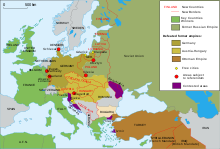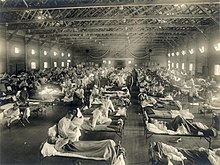Main article: Aftermath of World War I
In the aftermath of the war, four empires disappeared: the German, Austro-Hungarian, Ottoman, and Russian. Numerous nations regained their former independence, and new ones created. Four dynasties, together with their ancillary aristocracies, all fell as a result of the war: the Romanovs, the Hohenzollerns, theHabsburgs, and the Ottomans. Belgium and Serbia were badly damaged, as was France, with 1.4 million soldiers dead,[179] not counting other casualties. Germany and Russia were similarly affected.[180]
Formal end of the war
A formal state of war between the two sides persisted for another seven months, until the signing of the Treaty of Versailles with Germany on 28 June 1919. The United States Senate did not ratify the treaty despite public support for it,[181][182]and did not formally end its involvement in the war until the Knox–Porter Resolution was signed on 2 July 1921 by PresidentWarren G. Harding.[183] For the United Kingdom and the British Empire, the state of war ceased under the provisions of theTermination of the Present War (Definition) Act 1918 with respect to:
After the Treaty of Versailles, treaties with Austria, Hungary, Bulgaria, and the Ottoman Empire were signed. However, the negotiation of the latter treaty with the Ottoman Empire was followed by strife (the Turkish War of Independence), and a final peace treaty between the Allied Powers and the country that would shortly become the Republic of Turkey was not signed until 24 July 1923, at Lausanne.
Some war memorials date the end of the war as being when the Versailles Treaty was signed in 1919, which was when many of the troops serving abroad finally returned to their home countries; by contrast, most commemorations of the war's end concentrate on the armistice of 11 November 1918. Legally, the formal peace treaties were not complete until the last, the Treaty of Lausanne, was signed. Under its terms, the Allied forces divested Constantinople on 23 August 1923.
Peace treaties and national boundaries
After the war, the Paris Peace Conference imposed a series of peace treaties on the Central Powers officially ending the war. The 1919 Treaty of Versailles dealt with Germany, and building on Wilson's 14th point, brought into being the League of Nations on 28 June 1919.[189][190]
The Central Powers had to acknowledge responsibility for "all the loss and damage to which the Allied and Associated Governments and their nationals have been subjected as a consequence of the war imposed upon them by" their aggression. In the Treaty of Versailles, this statement was Article 231. This article became known as War Guilt clause as the majority of Germans felt humiliated and resentful.[191]Overall the Germans felt they had been unjustly dealt by what they called the "diktatof Versailles." Schulze says, the Treaty placed Germany, "under legal sanctions, deprived of military power, economically ruined, and politically humiliated."[192]Belgian historian Laurence Van Ypersele emphasizes the central role played by memory of the war and the Versailles Treaty in German politics in the 1920s and 1930s:
- Active denial of war guilt in Germany and German resentment at both reparations and continued Allied occupation of the Rhineland made widespread revision of the meaning and memory of the war problematic. The legend of the "stab in the back" and the wish to revise the "Versailles diktat", and the belief in an international threat aimed at the elimination of the German nation persisted at the heart of German politics. Even a man of peace such as Stresemann publicly rejected German guilt. As for the Nazis, they waved the banners of domestic treason and international conspiracy in an attempt to galvanize the German nation into a spirit of revenge. Like a Fascist Italy, Nazi Germany sought to redirect the memory of the war to the benefit of its own policies.[193]
Meanwhile, new nations liberated from German rule viewed the treaty as recognition of wrongs committed against small nations by much larger aggressive neighbors.[194] The Peace Conference required all the defeated powers to payreparations for all the damage done to civilians. However, owing to economic difficulties and Germany being the only defeated power with an intact economy, the burden fell largely on Germany.
Austria-Hungary was partitioned into several successor states, including Austria, Hungary, Czechoslovakia and Yugoslavia, largely but not entirely along ethnic lines. Transylvania was shifted from Hungary to Greater Romania. The details were contained in the Treaty of Saint-Germain and the Treaty of Trianon. As a result of the Treaty of Trianon, 3.3 million Hungarians came under foreign rule. Although the Hungarians made up 54% of the population of the pre-war Kingdom of Hungary, only 32% of its territory was left to Hungary. Between 1920 and 1924, 354,000 Hungarians fled former Hungarian territories attached to Romania, Czechoslovakia, and Yugoslavia.[195]
The Russian Empire, which had withdrawn from the war in 1917 after the October Revolution, lost much of its western frontier as the newly independent nations ofEstonia, Finland, Latvia, Lithuania, and Poland were carved from it. Romania took control of Bessarabia in April 1918.[196]
The Ottoman Empire disintegrated, and much of its non-Anatolian territory was awarded to various Allied powers as protectorates. The Turkish core in Anatolia was reorganised as the Republic of Turkey. The Ottoman Empire was to be partitioned by the Treaty of Sèvres of 1920. This treaty was never ratified by the Sultan and was rejected by the Turkish National Movement, leading to the victorious Turkish War of Independence and the much less stringent 1923 Treaty of Lausanne.
National identities
Further information: Sykes–Picot Agreement
Poland reemerged as an independent country, after more than a century. The Kingdom of Serbia and its dynasty, as a "minor Entente nation" and the country with the most casualties per capita,[197][198][199] became the backbone of a new multinational state, the Kingdom of Serbs, Croats and Slovenes, later renamed Yugoslavia. Czechoslovakia, combining theKingdom of Bohemia with parts of the Kingdom of Hungary, became a new nation. Russia became the Soviet Union and lost Finland, Estonia, Lithuania, and Latvia, which became independent countries. The Ottoman Empire was soon replaced by Turkey and several other countries in the Middle East.
In the British Empire, the war unleashed new forms of nationalism. In Australia and New Zealand the Battle of Gallipoli became known as those nations' "Baptism of Fire". It was the first major war in which the newly established countries fought, and it was one of the first times that Australian troops fought as Australians, not just subjects of the British Crown. Anzac Day, commemorating the Australian and New Zealand Army Corps, celebrates this defining moment.[200][201]
After the Battle of Vimy Ridge, where the Canadian divisions fought together for the first time as a single corps, Canadians began to refer to theirs as a nation "forged from fire".[202] Having succeeded on the same battleground where the "mother countries" had previously faltered, they were for the first time respected internationally for their own accomplishments. Canada entered the war as a Dominion of the British Empire and remained so, although it emerged with a greater measure of independence.[203][204] When Britain declared war in 1914, the dominions were automatically at war; at the conclusion, Canada, Australia, New Zealand, and South Africa were individual signatories of the Treaty of Versailles.[205]
The establishment of the modern state of Israel and the roots of the continuing Israeli–Palestinian conflict are partially found in the unstable power dynamics of the Middle East that resulted from World War I.[206] Before the end of the war, theOttoman Empire had maintained a modest level of peace and stability throughout the Middle East.[207] With the fall of the Ottoman government, power vacuums developed and conflicting claims to land and nationhood began to emerge.[208] The political boundaries drawn by the victors of World War I were quickly imposed, sometimes after only cursory consultation with the local population. These continue to be problematic in the 21st-century struggles for national identity.[209][210] While the dissolution of the Ottoman Empire at the end of World War I was pivotal in contributing to the modern political situation of the Middle East, including the Arab-Israeli conflict,[211][212][213] the end of Ottoman rule also spawned lesser known disputes over water and other natural resources.[214]
Health effects
The war had profound consequences in the health of soldiers. Of the 60 million European military personnel who were mobilized from 1914 to 1918, 8 million were killed, 7 million were permanently disabled, and 15 million were seriously injured. Germany lost 15.1% of its active male population, Austria-Hungary lost 17.1%, and France lost 10.5%.[215] In Germany, civilian deaths were 474,000 higher than in peacetime, due in large part to food shortages and malnutrition that weakened resistance to disease.[216] By the end of the war, starvation caused by famine had killed approximately 100,000 people in Lebanon.[217] Between 5 and 10 million people died in the Russian famine of 1921.[218] By 1922, there were between 4.5 million and 7 million homeless children in Russia as a result of nearly a decade of devastation from World War I, the Russian Civil War, and the subsequent famine of 1920–1922.[219] Numerous anti-Soviet Russians fled the country after the Revolution; by the 1930s, the northern Chinese city of Harbin had 100,000 Russians.[220] Thousands more emigrated to France, England, and the United States.
In Australia, the effects of the war on the economy were no less severe. The Australian prime minister, Billy Hughes, wrote to the British prime minister, Lloyd George, "You have assured us that you cannot get better terms. I much regret it, and hope even now that some way may be found of securing agreement for demanding reparation commensurate with the tremendous sacrifices made by the British Empire and her Allies." Australia received ₤5,571,720 war reparations, but the direct cost of the war to Australia had been ₤376,993,052, and, by the mid-1930s, repatriation pensions, war gratuities, interest and sinking fund charges were ₤831,280,947.[221] Of about 416,000 Australians who served, about 60,000 were killed and another 152,000 were wounded.[222]
Diseases flourished in the chaotic wartime conditions. In 1914 alone, louse-borne epidemic typhus killed 200,000 in Serbia.[223] From 1918 to 1922, Russia had about 25 million infections and 3 million deaths from epidemic typhus.[224] In 1923, 13 million Russians contracted malaria, a sharp increase from the pre-war years.[225] In addition, a major influenza epidemic spread around the world. Overall, the 1918 flu pandemic killed at least 50 million people.[226][227]
Lobbying by Chaim Weizmann and fear that American Jews would encourage the United States to support Germany culminated in the British government's Balfour Declaration of 1917, endorsing creation of a Jewish homeland in Palestine.[228] A total of more than 1,172,000 Jewish soldiers served in the Allied and Central Power forces in World War I, including 275,000 in Austria-Hungary and 450,000 in Czarist Russia.[229]
The social disruption and widespread violence of the Russian Revolution of 1917 and the ensuing Russian Civil Warsparked more than 2,000 pogroms in the former Russian Empire, mostly in Ukraine.[230] An estimated 60,000–200,000 civilian Jews were killed in the atrocities.[231]
In the aftermath of World War I, Greece fought against Turkish nationalists led by Mustafa Kemal, a war which eventually resulted in a massive population exchange between the two countries under the Treaty of Lausanne.[232] According to various sources,[233] several hundred thousand Greeks died during this period, which was tied in with the Greek Genocide.[234]






ليست هناك تعليقات:
إرسال تعليق